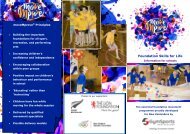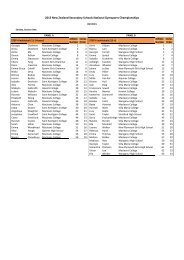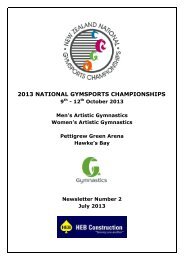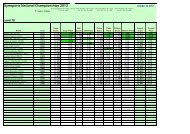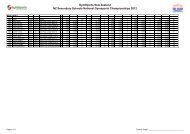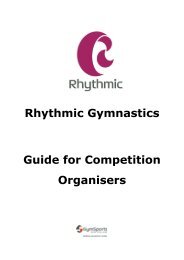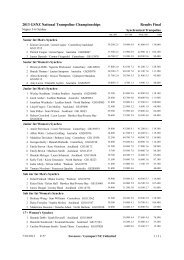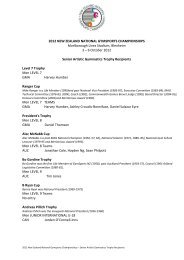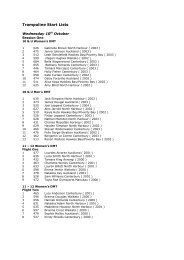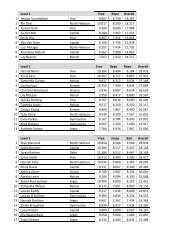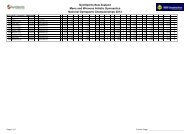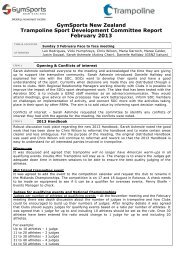Rhythmic Gymnastics Levels Handbook 2012 - Gym Sports
Rhythmic Gymnastics Levels Handbook 2012 - Gym Sports
Rhythmic Gymnastics Levels Handbook 2012 - Gym Sports
Create successful ePaper yourself
Turn your PDF publications into a flip-book with our unique Google optimized e-Paper software.
IntroductionOverview of New ZealandCompetitive StructureThis manual is intended to cover the major <strong>Rhythmic</strong> <strong><strong>Gym</strong>nastics</strong> competitiongrades offered throughout New Zealand. The streams are:Stages and International Grades:These grades are designed to prepare gymnasts to compete at an internationallevel. The Stages and International grades which are offered in New Zealand are:• Senior International - Age requirement: min turning 16 in year ofcompetition. FIG senior international requirements as per the FIG RGCode of Points• Junior International – Age requirements: min turning 13/max turning 15 inyear of competition. FIG junior international requirements as per the FIG RGCode of Points• Stage 4 – Age requirement: min turning 10/max turning 12 in year ofcompetition.• Stage 3 – Age requirement: min turning 9/max turning 11 in year ofcompetition.<strong>Levels</strong> Grades:The <strong>Levels</strong> grades are designed to be ability, as opposed to age based, thus thereis no age restrictions on any of the <strong>Levels</strong> grades. Ideally a gymnast begins inLevel 1 and progresses through the <strong>Levels</strong> as their skills increase, howevergymnasts do not have to start in Level 1.The <strong>Gym</strong><strong>Sports</strong> New Zealand <strong>Levels</strong> programme is closely aligned with the FIGCode in that the gymnasts have a choice of what difficulties they perform, thusthey will be able to perform difficulties that suit them best, as well as beingrewarded for performing more complex apparatus handling.The <strong>Levels</strong> offered are:• <strong>Levels</strong> 1, 2 and 3 – Offered at a club and regional level only (not offered atthe New Zealand National Championships). These <strong>Levels</strong> are designed togive gymnasts an introduction into competitive rhythmic gymnastics and thefocus should be on introducing fundamental moves with correct posture andbasic apparatus technique so as to give a good grounding for more difficultmovements to be introduced at the higher levels.• <strong>Levels</strong> 4 and 5 – These are the first <strong>Levels</strong> that are offered at the NewZealand National Championships. In body work, both flexibility andstrength should be introduced to a greater extent in a progressive way.The emphasis in apparatus handling should still be on basic technique:apparatus technique should be well formed, without statism and shouldshow variety amongst technical groups.• <strong>Levels</strong> 6, 7 and 8 – By now gymnasts should have a good foundation inrhythmic gymnastics. <strong>Gym</strong>nasts should be in a position of coordinating bodydifficulties with more complex apparatus handling, and thus more scope isgiven to show a variety of apparatus handling.<strong>Rhythmic</strong> <strong><strong>Gym</strong>nastics</strong><strong>Gym</strong><strong>Sports</strong> New Zealand – Making Movement Matter2
Requirements for New Zealand <strong>Levels</strong> 1-10Level12345RoutineD1-BodyDifficultiesFree 6Apparatus 6Distributionwith respectto BodyGroupsMin 1, Max 2of each2+2 GCO‟s+ 2 optionalBodyDifficultiesValueallowedMax D1Max D2MaxDifficultyScore(D1+D2)/2MaxArtistryMaxExecutionMaxFinalScoreNA-C 1.80 pts 3.00 pts 2.4 pts 0.00 pts 10.00 pts 12.40 ptsNA-C 1.80 pts 3.00 pts 2.4 pts 0.00 pts 10.00 pts 12.40 ptsFree 8 2 of each NA-C 2.40 pts 3.00 pts 2.70 pts 0.00 pts 10.00 pts 12.70 ptsApparatus 62+2 GCO‟s+ 2 optionalNA-C 1.80 pts 3.00 pts 2.40 pts 0.00 pts 10.00 pts 12.40 ptsFree 8 2 of each NA-C 2.40 pts 3.00 pts 2.70 pts 0.00 pts 10.00 pts 12.70 ptsApparatus 62+2 GCO‟s+ 2 optionalNA-C 1.80 pts 5.00 pts 3.40 pts 0.00 pts 10.00 pts 13.40 ptsFree 8 2 of each NA-D 3.20 pts 3.00 pts 3.10 pts 10.00 pts 10.00 pts 23.10 ptsApparatus 83+3 GCO‟s+ 2 optionalNA-D 3.20 pts 5.00 pts 4.10 pts 10.00 pts 10.00 pts 24.10 ptsFree 8 2 of each NA-E 4.00 pts 3.00 pts 3.50 pts 10.00 pts 10.00 pts 23.50 ptsApparatus 86 Apparatus 97 Apparatus 98 Apparatus 109 Apparatus 1010 Apparatus 123+3 GCO‟s+ 2 optional3+3 GCO‟s+ 3 optional3+3 GCO‟s+ 3 optional3+3 GCO‟s+ 4 optional3+3 GCO‟s+ 4 optional4+4 GCO‟s+ 4 optionalNA-E 4.00 pts 7.00 pts 5.50 pts 10.00 pts 10.00 pts 25.50 ptsMusicLength45”-1‟15”45”-1‟15”1‟00”-1‟30”1‟00”-1‟30”1‟00”-1‟30”NA-F 5.40 pts 7.00 pts 6.20 pts 10.00 pts 10.00 pts 26.20 pts 1‟00”-1‟30”A-F 5.40 pts 10.00 pts 7.70 pts 10.00 pts 10.00 pts 27.70 pts 1‟15”-1‟30”Any FIGAny FIGAny FIG7.00 pts7.00 pts10.00 pts10.00 ptsMin 1 Risk10.00 ptsMin 2 Risks10.00 ptsMin 3 Risks8.50 pts 10.00 pts 10.00 pts 28.50 pts 1‟15”-1‟30”8.50 pts 10.00 pts 10.00 pts 28.50 pts 1‟15”-1‟30”10.00 pts 10.00 pts 10.00 pts 30.00 pts 1‟15”-1‟30”Notes:• GCO refers to the specific body group for the apparatus: ROPE-Leaps and Pivots, HOOP-an equal mix of all four (<strong>Levels</strong> 1-3 min 1 max 2 of each,<strong>Levels</strong> 4-5 min 2 of each, <strong>Levels</strong> 6-10 min 2 of each), BALL-Flexibilities and Leaps, CLUBS-Balances and Pivots, RIBBON-Pivots and Leaps• <strong>Levels</strong> 1-3: National A Leaps, Pivots and Flexions can be used for D1 • Optional body difficulties can be from any group• <strong>Levels</strong> 1-6: National A Flexions can be used for D1 • <strong>Levels</strong> 1-7: Risk not required for D2 but may be included• <strong>Levels</strong> 1-6: Difficulties may be performed without mastery but must be performed with a movement from a technical group.• If a gymnast forgets more than 75% of their routine the routine will not be evaluated. This is at the discretion of the head judge for the session.<strong>Rhythmic</strong> <strong><strong>Gym</strong>nastics</strong><strong>Gym</strong><strong>Sports</strong> New Zealand – Making Movement Matter4
Requirements for New Zealand Stage 3 & 4, Junior & SeniorInternationalLevelRoutineD1-BodyDifficultiesDistributionwith respectto BodyGroupsBodyDifficulties ValueallowedMax D1Max D2MaxDifficultyScore(D1+D2)/2MaxArtistryMaxExecutionMaxFinalScoreMusicLengthStage 3Free 10Apparatus 8Min 1, Max 3 ofeach3+3 GCO‟s+ 2 optionalA-H 8.00 pts 0.00 pts 4.0 pts 10.00 pts 10.00 pts 24.00 ptsA-F 4.80 pts 6.00 pts 5.4 pts 10.00 pts 10.00 pts 25.40 pts1‟15”-1‟30”Stage 4 Apparatus 103+3 GCO‟s+ 4 optionalAny FIG7.00 pts10.00 ptsMin 1 Risk8.50 pts 10.00 pts 10.00 pts 28.50 pts1‟15”-1‟30”JuniorInternationalApparatus 103+3 GCO‟s+ 4 optionalAny FIG7.00 pts10.00 ptsMin 2 Risk8.50 pts 10.00 pts 10.00 pts 28.50 pts1‟15”-1‟30”SeniorInternationalApparatus 124+4 GCO‟s+ 4 optionalAny FIG10.00 pts10.00 ptsMin 3 Risk10.00 pts 10.00 pts 10.00 pts 30.00 pts1‟15”-1‟30”Notes: GCO refers to the specific body group for the apparatus: ROPE-Leaps and Pivots, HOOP-an equal mix of all four (<strong>Levels</strong> 1-3 min 1 max 2 of each, <strong>Levels</strong> 4-5 min 2 of each, <strong>Levels</strong> 6-10 min 2 of each), BALL-Flexibilities and Leaps, CLUBS-Balances and Pivots, RIBBON-Pivots and Leaps<strong>Rhythmic</strong> <strong><strong>Gym</strong>nastics</strong><strong>Gym</strong><strong>Sports</strong> New Zealand – Making Movement Matter5
Requirements for New Zealand GroupsGradeApparatusD1-BodyDifficultiesMinimumNumber ofExchangesBodyDifficultiesValueallowedMax D1Max D2MaxDifficultyScore(D1+D2)/2MaxArtistryMaxExecutionMaxFinalScoreMusicLengthGrade 1 Free 6NoexchangesBodydifficulties Min1, Max 2 fromeach groupNA-C 1.8 pts 2.00 pts 1.9 pts 10.00 pts 10.00 pts 21.90 pts1‟00”-2‟00”Grade 2 Hoop or Ball 8Min 3exchangesMin 1 withthrow, can userolling orbouncing (notpassing)Any (Valueof eachdifficulty1.00 pt max)5.00 pts 7.00 pts 6.00 pts 10.00 pts 10.00 pts 26.00 pts1‟00”-2‟00”Grade 4SameApparatus10Min 4exchanges Allwith throwAny (Valueof eachdifficulty1.00 pt max)7.00 pts 10.00 pts 8.50 pts 10.00 pts 10.00 pts 28.50 pts2‟00”-2‟30”Grade 5MixedApparatus12Min 5exchangesAny FIG 10.00 pts 10.00 pts 10.00 pts 10.00 pts 10.00 pts 30.00 pts2‟00”-2‟30”Grade 6 (JuniorInternational)5 Ropes, 5Balls10Min 4exchangesAny FIG 7.00 pts 10.00 pts 8.50 pts 10.00 pts 10.00 pts 28.50 pts2‟15”-2‟30”Grade 7 (SeniorInternational)5 Balls, 3Ribbons & 2Hoops14Min 6exchangesAny FIG 10.00 pts 10.00 pts 10.00 pts 10.00 pts 10.00 pts 30.00 pts2‟15”-2‟30”Notes: Grade 2 and 4 only-Difficulties with exchange of apparatus have the following value:‣ B-Exchange = 0.20 point (0.00 body movement + 0.20 for exchange difficulty with bounce or roll)‣ C Exchange = 0.30 point (0.00 body movement + 0.30 for exchange difficulty)<strong>Rhythmic</strong> <strong><strong>Gym</strong>nastics</strong><strong>Gym</strong><strong>Sports</strong> New Zealand – Making Movement Matter6
National A’sNational A‟s are difficulties that are only recognised in New Zealand and are validas difficulties for <strong>Levels</strong> 1-3 only. Each has a value of 0.10.LeapsNA NA NAPivotsNAFlexionsNANote: Total body wave is now a recognised A difficultyAdditional National A’s (flexions only) Level 1-6On top of the National A‟s listed above, there are additional National A flexionsthat are only recognised as difficulties in New Zealand. These additional flexionsare valid as difficulties for <strong>Levels</strong> 1-6 only and each has a value of 0.10.NA NA NANA NA NANA NA NA NA<strong>Rhythmic</strong> <strong><strong>Gym</strong>nastics</strong><strong>Gym</strong><strong>Sports</strong> New Zealand – Making Movement Matter7
Freehand Difficulty 2(Valid for <strong>Levels</strong> 1-5 Freehand routines)A maximum of 3.00 pts in “freehand Difficulty 2” can be incorporated intofreehand routines.D2 elements can come from one of four groups:‣ Bodywaves‣ Elements of rotations‣ Movement of arms during a balance or flexion‣ <strong>Rhythmic</strong> steps<strong>Gym</strong>nasts may ask for unlimited points from each group.The “freehand D2” symbols are:Symbol Value Description0.10 A series of rhythmic steps0.100.100.200.30Movements of the arms during a balance or flexion (series ofsmall movements of the wrists, swings, circles etc)A single dynamic element with rotation e.g. rolls, walkovers,cartwheels, chaines.A series of two dynamic elements with rotation e.g. rolls,walkovers, cartwheels, chaines.A series of three dynamic elements with rotation e.g. rolls,walkovers, cartwheels, chaines.0.10 A bodywave0.100.10For each change of body rotation axis within a series ofdynamic elements with rotationFor each change of gymnast level within a series of dynamicelements with rotation (3 levels: gymnast in flight, standing,on the floor).These elements should be listed on the D2 section of the routine sheets in theorder that they are performed, and in relation to the body difficulties in theroutine.The dynamic elements that can be used for D2 in <strong>Levels</strong> 1 to 5 Freehand shouldbe performed correctly and „dynamically‟ like the ones under throws areperformed in apparatus routines.<strong>Rhythmic</strong> <strong><strong>Gym</strong>nastics</strong><strong>Gym</strong><strong>Sports</strong> New Zealand – Making Movement Matter8
Prohibited DifficultiesThe following difficulties are prohibited for the <strong>Levels</strong> specified in an effort to helpprevent injury. Failure to comply with these rules will result in a 0.50 ptsdeduction from the final score. Any Balances performed on the knee in Stage 3 and <strong>Levels</strong> 1-3 routines Any Flexion that uses the back scale position in Stage 3 and <strong>Levels</strong> 1-5 routines<strong>Rhythmic</strong> <strong><strong>Gym</strong>nastics</strong><strong>Gym</strong><strong>Sports</strong> New Zealand – Making Movement Matter9
New Zealand Apparatus NormsInternational GradesSenior International – Refer to the „FIG Apparatus Norms‟Junior International / Stage 4 – Refer to the „FIG Apparatus Norms‟, with thefollowing exceptions:‣ Ribbon length is a minimum of 5m, no weight requirementStage 3 – Refer to the „FIG Apparatus Norms‟, with the following exceptions:‣ Hoop is either proportionate to size of gymnast* or meets FIG size requirements,and there is no weight requirement‣ Ball minimum diameter of 15cm, no weight requirement‣ Junior clubs may be used (36cm min)‣ Ribbon length is a minimum of 4.5m, no weight requirement<strong>Levels</strong> GradesLevel 7 to 10 – Refer to the „FIG Apparatus Norms‟, with the following exception:‣ <strong>Levels</strong> 7-9 Ribbon length is a minimum of 5m, no weight requirement.Note: the <strong>Rhythmic</strong> SDC recommends that gymnasts use a 6m ribbon, as gymnastswith short ribbons run the risk of being deducted for insufficient patterns.Level 5 to 6 – Refer to the „FIG Apparatus Norms‟, with the following exceptions:‣ Hoop is either proportionate to size of gymnast* or meets FIG size requirements,and there is no weight requirement.‣ Ribbon length is a minimum of 5m, no weight requirementLevel 1 to 4 – Refer to the „FIG Apparatus Norms‟, with the following exceptions:‣ Hoop is either proportionate to size of gymnast* or meets FIG size requirements,and there is no weight requirement.‣ Ball minimum diameter of 15cm, no weight requirement‣ Ribbon length is a minimum of 4.5m, no weight requirement‣ Junior clubs may be used (36cm min)GroupsGrade VII Group – Refer to the „FIG Apparatus Norms‟Grade VI Group – Refer to the „FIG Apparatus Norms‟, with the following exception:‣ Ribbon length is a minimum of 5m, no weight requirementGrade IV-V Group – Refer to the „FIG Apparatus Norms‟, except:‣ Hoop is either proportionate to size of gymnast* or meets FIG size requirements,and there is no weight requirement.‣ Ribbon length is a minimum of 5m, no weight requirement.Note: the <strong>Rhythmic</strong> SDC recommends that gymnasts use a 6m ribbon, as gymnastswith short ribbons run the risk of being deducted for insufficient patterns.Grade II Group – Refer to the „FIG Apparatus Norms‟, except:‣ Hoop is either proportionate to size of gymnast* or meets FIG size requirements,and there is no weight requirement.‣ Ball minimum diameter of 15cm, no weight requirement‣ Ribbon length is a minimum of 4.5m, no weight requirement‣ Junior clubs may be used (36cm min)*Hoop „proportionate to size of gymnast‟ refer to the following as a guide; restingupright on the floor, beside the gymnast, the top of the hoop comes at least to the legline of the leotard.<strong>Rhythmic</strong> <strong><strong>Gym</strong>nastics</strong><strong>Gym</strong><strong>Sports</strong> New Zealand – Making Movement Matter11
FIG Apparatus NormsRope‣ Hemp or synthetic material‣ Length proportionate to size of gymnast i.e. no specific length requirement‣ No handles except for one or two knots at each end‣ Maximum of 10cm at the ends may be covered by an anti slip materialHoop‣ Wood or plastic‣ Interior diameter of 80-90cm‣ Minimum weight of 300g‣ Can be taped in any colourBall‣ Rubber or synthetic‣ Diameter of 18-20cm‣ Minimum weight of 400g‣ Any colourClubs‣ Wood or synthetic‣ Length of 40-50cm‣ Minimum weight of 150g per club‣ Can be taped in any colourRibbonStick‣ Wood, bamboo, plastic or fibreglass‣ Length of 50-60cm (including the ring at the end of the stick)‣ Diameter maximum of 1cm‣ Maximum weight 35g‣ Bottom end may be covered by an anti slip material for a maximum length of 10cm‣ Any colourRibbon‣ Satin or similar material (without starch)‣ Width 4-6cm‣ Doubled at stick end for a maximum of 1 metre‣ Total length minimum of 6m‣ Minimum weight of 35g‣ Attachment to the stick is a maximum of 7cm (not counting the ring at the end of thestick)‣ Any colour<strong>Rhythmic</strong> <strong><strong>Gym</strong>nastics</strong><strong>Gym</strong><strong>Sports</strong> New Zealand – Making Movement Matter12
Starting PointNZ National <strong>Levels</strong> ProgrammeIt is suggested that every gymnast wanting to compete in the National System starts atLevel 1; however gymnasts starting the sport at 10yrs or older may already have thebasic skills to begin at a higher Level.Once a gymnast has competed in a particular Level at a sanctioned competition, theycannot compete in a lower Level. Award scheme and qualification system will determinethe competing Level.The <strong>Rhythmic</strong> <strong>Sports</strong> Development Committee (SDC) reserves the right to regrade agymnast due to extenuating circumstances.Passing a LevelThe idea of the <strong>Levels</strong> system is that gymnasts can systematically progress through thelevels, starting at 1 and finishing at 10. A gymnast „passes‟ a Level when she achievesa certain standard. This can be done by:Either(i) Achieving an all around total pass mark at a single competition or achieving thepass mark in each apparatus at separate competitions(ii) And having her <strong>Levels</strong> card (showing competition results) verified by <strong>Gym</strong><strong>Sports</strong> NZ(refer pg 14)Or (applicable to <strong>Levels</strong> 1 to 6 only)(i) Attending a „testing day‟ (in effect a “mini-competition”) where gymnasts mustperform full competition routines, and are judged under the same criteria as asanctioned competition.(ii) And having her <strong>Levels</strong> card verified by <strong>Gym</strong><strong>Sports</strong> New Zealand.Note: <strong>Gym</strong>nasts only have to pass the apparatus required for that year.Once a gymnast achieves the pass mark in any of the ways outlined above, that gymnastmust progress to the next Level in the following year of competition. The only exceptionsto this are:‣ <strong>Gym</strong>nasts in <strong>Levels</strong> 7-9 may remain in their Level for 2 years regardless of themarks achieved in the first year. In extenuating circumstances the RG Sport Development Committee canrequest that a gymnast must progress to the next Level at the end of thefirst year OR A coach can apply to have a gymnast remain in <strong>Levels</strong> 7-9 for longer than 2years using an Application for Regrade form (refer pg 19).‣ Level 10 gymnasts may stay in Level 10 indefinitely.‣ If for some reason a gymnast has a significant break from competitivegymnastics, an application may be made to <strong>Gym</strong><strong>Sports</strong> NZ for consideration torecommence competition at an appropriate Level, using an Application forRegrade form (refer pg 19).‣ If a coach would like a gymnast to remain in a particular Level despite achievingthe pass mark, or would like a gymnast to skip a Level can apply to <strong>Gym</strong><strong>Sports</strong>NZ to request a gymnast stays in a particular level, using an Application forRegrade form (refer pg 19).Note: A gymnast may progress through more than one Level in a season.<strong>Rhythmic</strong> <strong><strong>Gym</strong>nastics</strong><strong>Gym</strong><strong>Sports</strong> New Zealand – Making Movement Matter13
<strong>Levels</strong> Card SubmissionFollowing completion of the year‟s competitions, Clubs should submit ALL cards to<strong>Gym</strong><strong>Sports</strong> NZ (at the address below) by 1 December irrespective of whether they relateto gymnasts who have qualified at a level or not.National Office Coordinator<strong>Gym</strong><strong>Sports</strong> New ZealandP.O. Box 9485NewmarketAucklandIf however a coach would like to progress a gymnast within a season, when it isconsidered that a gymnast has achieved the standard to advance to the next Level,her <strong>Levels</strong> card must be sent for verification.When a gymnast competes at the next level, this verification must be produced tocompetition organisers.Following verification, the gymnast is eligible to purchase the corresponding levelsbadge. A levels badge authorisation / order form will be returned with the levels card.When submitting cards, please enclose a stamped addressed envelope for return.Running a Testing Day (<strong>Levels</strong> 1-6)PreparationSend an email to the <strong>Rhythmic</strong> Sport Development Committee Judging Advisor outliningyour intent to hold a <strong>Levels</strong> Testing Day along with the following information:‣ The names of the judges to conduct the testing (a minimum of 3 judges, at leastone Level 3 or higher) including at least one neutral judge (not from the clubhosting the testing day)‣ Date and Venue of Testing Day‣ Names and <strong>Levels</strong> of each <strong>Gym</strong>nastsYou will need to receive confirmation that you are able to hold the testing day beforegoing ahead; otherwise the marks will not be counted.On the Testing DayUse the standard competition recording sheet (if you do not have access to this pleasecontact the RG Sport Development Committee Judging Advisor).<strong>Gym</strong>nasts must perform full competition routines, and are judged under the samecriteria as a sanctioned competition.Note: <strong>Gym</strong>nasts are not required to re-sit apparatus they have already passed. Passmarks are the same as the pass marks in competitionAfter the Testing DayTranspose the marks for each routine onto the <strong>Levels</strong> Card for each gymnast and sendthem to GSNZ for verification along with a copy of the recording sheets.RibbonsWhen competing in the first competition at any level, each gymnast will be awarded aribbon on each of the apparatus she competes, the colour of which recognises herperformance level. Thereafter she will gain additional ribbons if her performance levelimproves to a higher score group.<strong>Rhythmic</strong> <strong><strong>Gym</strong>nastics</strong><strong>Gym</strong><strong>Sports</strong> New Zealand – Making Movement Matter14
Important PointsJudging panels must be submitted to the <strong>Rhythmic</strong> Sport Development CommitteeJudging Advisor for approval prior to a competition or testing day.A copy of the results, recording sheets and judge‟s panels from all competitions shouldbe sent to the <strong>Gym</strong><strong>Sports</strong> NZ Events Manager within 7 days of completion of thecompetition.<strong>Levels</strong> cards, ribbons and badges are available for purchase from <strong>Gym</strong><strong>Sports</strong> NZ.<strong>Gym</strong>nasts can pass a Level at a sanctioned event or an unsanctioned event as long asthe minimum judging panel requirements are met. <strong>Gym</strong>nasts can only qualify for GSNZNational Championships at a sanctioned event.<strong>Rhythmic</strong> <strong><strong>Gym</strong>nastics</strong><strong>Gym</strong><strong>Sports</strong> New Zealand – Making Movement Matter15
Pass MarksPass Marks & Ribbon MarksLevel Free Apparatus Overall1 6.75 6.50 13.252 7.00 6.75 20.503 7.25 7.00 21.254 13.00 12.50 38.005 13.00 12.50 38.006 N/A 12.50 37.507 N/A 12.50 50.008 N/A 13.25 53.009 N/A 13.50 54.0010 N/A 13.50 54.00Ribbon Marks<strong>Levels</strong> 1-3Green5.999 and underBlue 6.000-6.999Red 7.000-7.999Gold8.000 and over<strong>Levels</strong> 4-10 & Stage 3Green10.999 and underBlue 11.000-12.999Red 13.000-13.999Gold14.000 and over<strong>Rhythmic</strong> <strong><strong>Gym</strong>nastics</strong><strong>Gym</strong><strong>Sports</strong> New Zealand – Making Movement Matter16
<strong>Rhythmic</strong> <strong><strong>Gym</strong>nastics</strong> Application forRegrade<strong>Gym</strong>nast Name: ______________________________________________________Current Level: ________________ Level applying for: ________________________Club: ________________________________ Coach: ________________________Hours training per week: _______________________________________________Scores (totals) from last competition season:Please outline reasons for wanting to move to a different Level or maintain previousyears Level:Signed <strong>Gym</strong>nast: _____________________________________________________Signed Club Secretary: ________________________________________________Date: ________________________Return your completed form to GSNZ, P.O. Box 9485 Newmarket, Auckland<strong>Gym</strong><strong>Sports</strong> NZ <strong>Rhythmic</strong> <strong><strong>Gym</strong>nastics</strong> <strong>Sports</strong> Development CommitteeRegrading Application Reply<strong>Gym</strong>nast Name: _______________________________________________________Please note that you HAVE / HAVE NOT been granted a re-grade to compete inLevel _______Signed: ____________________________ <strong>Rhythmic</strong> SDCDate: ______________________<strong>Rhythmic</strong> <strong><strong>Gym</strong>nastics</strong><strong>Gym</strong><strong>Sports</strong> New Zealand – Making Movement Matter17
Additional ResourcesNeed Help? Any questions can in the first instance be addressed to the <strong>Rhythmic</strong><strong><strong>Gym</strong>nastics</strong> Sport Development Committee:Hannah Mills-Beale coachxtreme@hotmail.com ChairKeita McGowan keitajmcgowan@hotmail.com Judging AdvisorRoslyn Kerr roslyn.kerr@canterbury.ac.nz Events and ToursKatie Pearce katielpearce@gmail.com Athlete's RepresentativeTracey Redhead Tracey.Redhead@gymsport.co.nzFederation websites:Below is a list of websites and other information which may be of interest. This list isby no means comprehensive, but rather a good starting point:<strong>Gym</strong><strong>Sports</strong> New Zealand (GSNZ)‣ Homepage: www.gymsportsnz.com‣ Email: office@gymsportsnz.com‣ Ph: + 64 9 3773600 Fax: + 64 9 3773608International Federation of <strong><strong>Gym</strong>nastics</strong> (FIG):‣ The General homepage: http://www.fig-gymnastics.com‣ The <strong>Rhythmic</strong> homepage: www.fig-gymnastics.com/vsite/vnavsite/page/directory/0,10853,5187-188044-205266-nav-list,00.html‣ Keep an eye on the newsletters section in the column on the left hand side onthe rhythmic homepage‣ The code of points are also available for download in the column on the left handside on the rhythmic homepage<strong><strong>Gym</strong>nastics</strong> Australia:‣ Homepage: www.gymnastics.org.au‣ <strong>Rhythmic</strong> technical regulations:http://www.gymnastics.org.au/?Page=3286&MenuID=Technical_Information%2F20051%2F0%2C<strong>Rhythmic</strong>_<strong><strong>Gym</strong>nastics</strong>%2F20080%2F0%2F<strong>Rhythmic</strong> <strong><strong>Gym</strong>nastics</strong><strong>Gym</strong><strong>Sports</strong> New Zealand – Making Movement Matter18



